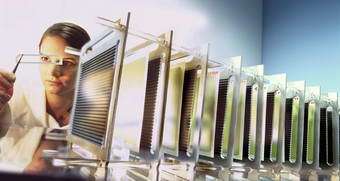A hot source of energy

Stacks of ceramic plates are capable of transforming fuels like natural gas into electricity using an electrochemical process. High-temperature fuel cells are ideal for use in power supply systems for buildings and vehicles. A young firm is planning their commercialization.
Image: A fuel-cell stack consists of a series-connected assembly of ceramic SOFC cells. Metallic connectors must assure electrical contact at temperatures above 800 °C. © Bayer AG
High-temperature fuel cells, unlike other types, are capable of producing electricity and heat not only from hydrogen or methanol but also from cheaper and more readily available energy sources such as natural gas, gasoline, diesel or biogas. A front-end reformer converts these fuels to hydrogen and carbon monoxide. But the high operating temperature of over 800 °C requires a correspondingly long period of pre-heating. For that reason, such fuel cells are best employed in situations where they continuously operate – particularly providing energy for buildings and vehicles.
In many cases they can often be designed to even use the process heat – thus ideally achieving an energy efficiency of over 90 percent. Solid-oxide fuel cells (SOFCs) have been a subject of research at the Fraunhofer Institute for Ceramic Technologies and Sintered Materials IKTS since 1992. They are cast or silk-screened in ceramic paste and then sintered to form plate electrodes of the required thinness. “We are the first to have developed a ceramic that prolongs the life of the plates by a factor of around ten with respect to previous types of material,” emphasizes institute director Professor Alexander Michaelis. “Moreover, they achieve the highest energy efficiency so far produced using a solid-oxide fuel cell.”
A single membrane electrode assembly, complete with connectors, has about the same dimensions as a CD and delivers an output of around 20 watts. By grouping them together in stacks, they generate sufficient power for the envisaged applications. A stack can serve as an auxiliary power unit (APU) for boats, camper cars and other vehicles. Such mobile devices are better able to meet the high electrical power requirements of modern vehicles than conventional alternators.
The emerging technology of fuel cells was not born yesterday. The IKTS has been cooperating with firms like Webasto AG and Bayer subsidiary HC Starck GmbH since 2003. The two partners have now formed a joint venture to develop fuel-cell stacks for APUs to industrial maturity. “We are confident that this is the right time to start marketing SOFC-based energy systems,” declares Dr. Christian Wunderlich, managing director of the new Staxera GmbH. “The important factors in our view are robust design, a smoothly running production line, and the ability to supply customers with a fully tested complete solution.” Concentrating on these three aspects, Staxera hopes to capture a major share of the market for decentralized energy systems. In this field the demand for solar energy systems is already increasing at a remarkable rate.
Source: Fraunhofer-Gesellschaft


















